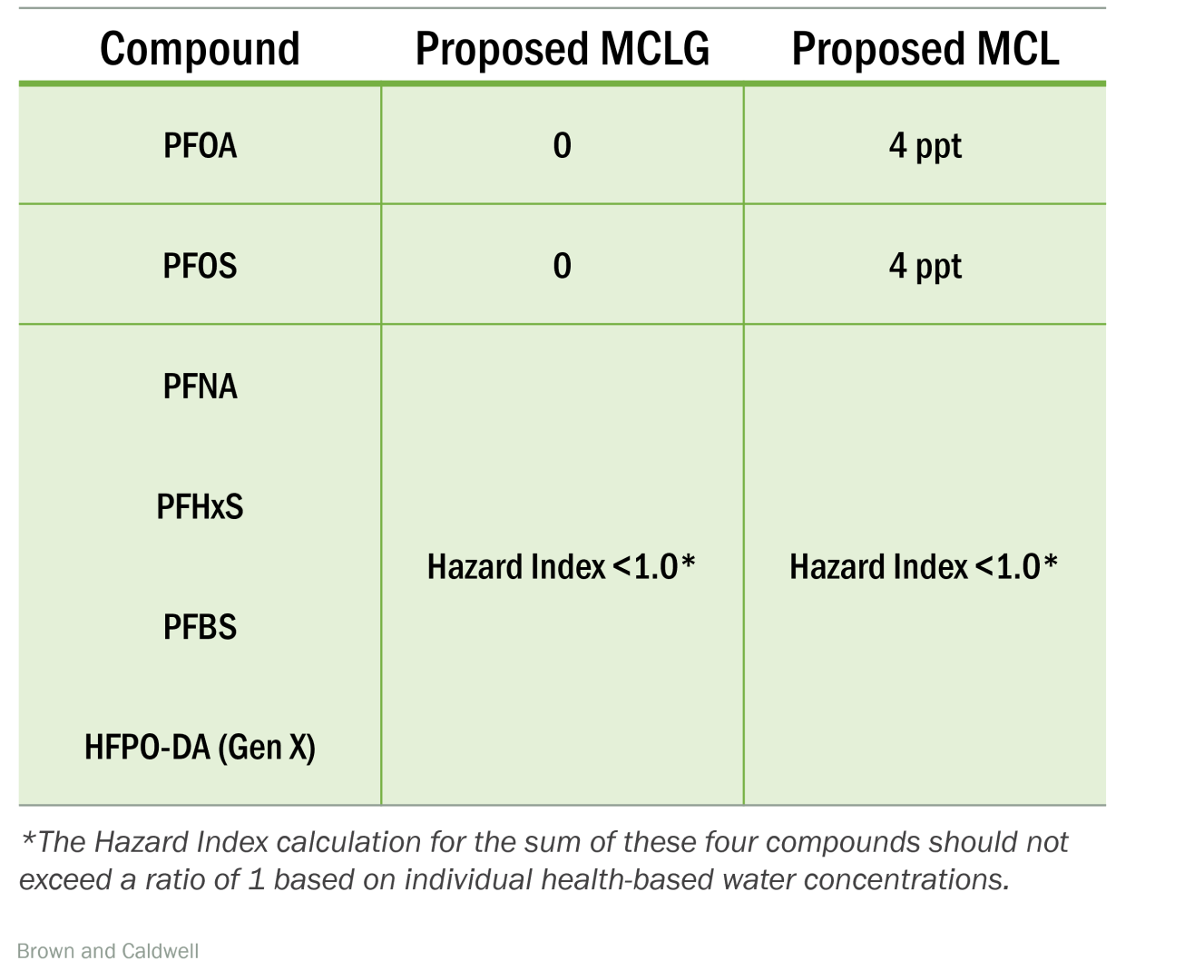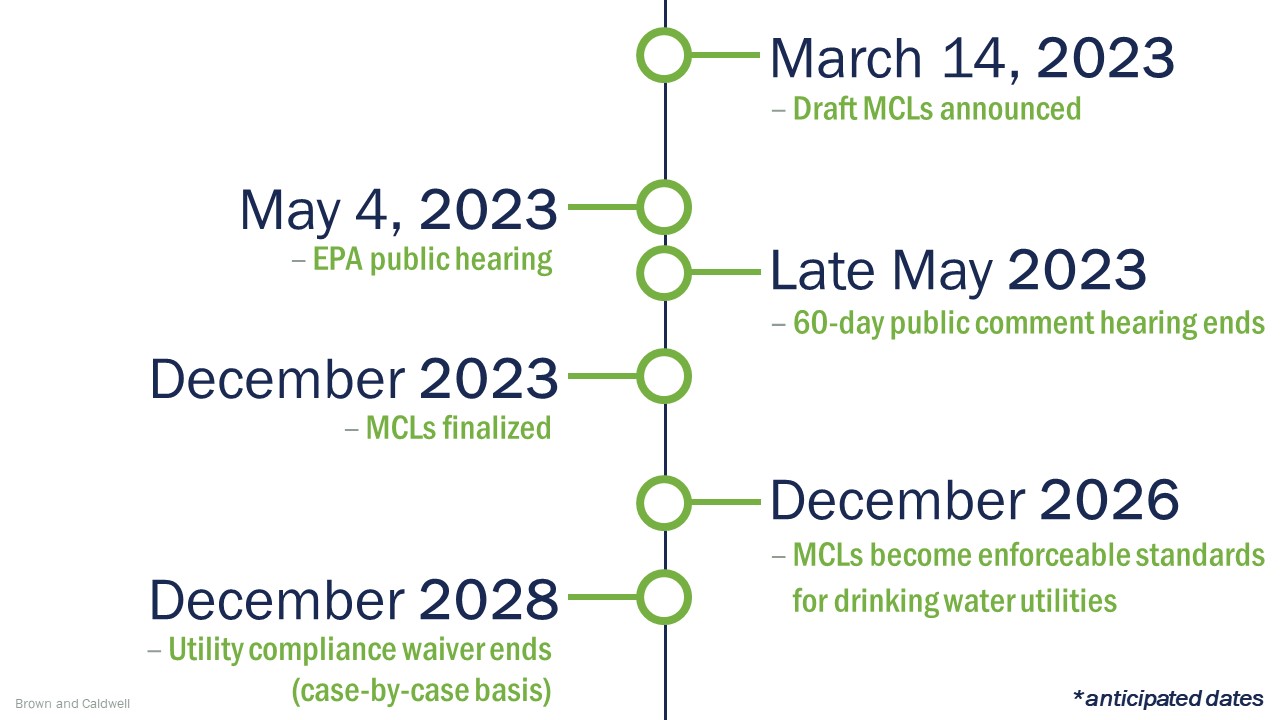On March 14, 2023, the U.S. EPA released their proposed drinking water Maximum Contaminant Levels (MCLs) and Maximum Contaminant Level Goals (MCLGs) for select per- and polyfluoroalkyl substances (PFAS). These draft MCLs will go through the formal approval process and are expected to become promulgated by the end of 2023, at which time they will be finalized to become enforceable standards by the end of 2026. These regulations will potentially create major requirements for drinking water utilities and other regulated parties nationwide.
Who is impacted?
The new MCLs will likely have far-reaching effects for facilities involved in any part of the water cycle. Primarily, these MCLs will be enforced for community water systems and non-transient, non-community water systems. The proposed regulations for these drinking water systems are:

These regulations will also likely effect public municipal clients, private sector industrial clients, and other organizations that manage the impacts of regulated contaminants to groundwater and surface water resources through site remediation programs, or wastewater and stormwater operations regulated under the Clean Water Act, NPDES permitting, and other programs.
What is the timeline*?

What can utilities do now?
Initially, drinking water utilities should sample their raw water and finished water to determine current PFAS levels. Due to the high potential for cross contamination, it is important to follow PFAS sampling standard operating procedures to promote sound data quality. If the results show a potential exceedance of the new MCLs, utilities will want to determine the desired course of action to address the exceedance.
Utilities should also evaluate the timing of the compliance window versus the anticipated time to enact your selected mitigation measure, as well as determine which funding mechanisms are appropriate for your situation. The solution that is right for your utility will depend on the exceedance amount, influent water quality, future capital improvement plans, and capital funding budgets, among other factors.
Additional actions a utility may consider include:
- Developing a proactive communications plan
- Creating an expanded monitoring program
- Blending available sources of supply
- Finding alternative sources
- Piloting/designing treatment systems
How can BC help?
Our team is ready to help you adapt to what’s emerging, from strategic planning to baseline sampling and trend analysis to bench and pilot testing of effective treatment technologies. We can help you navigate the complexities of PFAS compliance with appropriate offramps to avoid expensive treatment upgrades when possible.
For our utility clients, if treatment is the desired or necessary path, our engineers and scientists can work with you and our in-house treatability testing laboratory to perform bench- and pilot-scale testing to help you make informed decisions with the potential to reduce the cost and risk of facility design, construction, and operation. BC has made major investments in advanced testing and monitoring equipment to offer our clients access to conventional and innovative treatment technologies to meet their needs.
BC has communications experts who can assist in developing an outreach plan to help communicate these regulations and implications in a reassuring way to your drinking water customers. We can also help with identifying and applying for grant and loan opportunities related to PFAS treatment.
Together, we can help unlock your PFAS solutions with long-term reliability and sustainability in mind. Contact our PFAS experts below to learn how we can work together to address these new challenges.

 Kyle Hay, PE is a Senior Engineer at Brown and Caldwell focused on advising clients on drinking water quality and water treatment needs, as well as per- and polyfluoroalkyl substances (PFAS) response efforts. He has years of experience serving as a project manager, design manager, and project engineer on a variety of multi-year, multidisciplinary municipal projects. He co-leads BC’s
Kyle Hay, PE is a Senior Engineer at Brown and Caldwell focused on advising clients on drinking water quality and water treatment needs, as well as per- and polyfluoroalkyl substances (PFAS) response efforts. He has years of experience serving as a project manager, design manager, and project engineer on a variety of multi-year, multidisciplinary municipal projects. He co-leads BC’s  Dr. Jim Claffey, PE, is a National Technology Innovation Leader at BC with over 30 years of environmental consulting industry experience. He has expertise in the management of emerging contaminants, including
Dr. Jim Claffey, PE, is a National Technology Innovation Leader at BC with over 30 years of environmental consulting industry experience. He has expertise in the management of emerging contaminants, including